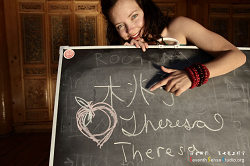There are many, many, amazing yoga teachers out there who—even though they aren’t standing on their little finger on some tropical island—are inspiring in their own quiet ways.
If I had a nickel for every time I saw a posted photo of a yoga teacher in handstand, I’d be a millionaire.
There is a fine line between shining your inner spiritual light brightly so that others feel inspired to do the same…and shining the light, a little too bright, blinding the onlookers.
I follow many yoga teachers who I admire on Facebook, Instagram and Twitter. Lately, while scrolling through my newsfeed looking for something inspiring to share with my own students, all I see is pictures of these beautiful teachers in challenging postures, in very exotic places.
Fact: I know from my own experience that the fancy stuff gets the most attention (a plethora of “likes”). My question is: in a world where social media unintentionally has an influence on participants’ emotional well being, who are these posts really serving and how?
…in February, 584 users of Facebook aged mostly in their 20s were surveyed. They found that the most common emotion aroused by using Facebook is envy. Endlessly comparing themselves with peers….this leaves Facebook’s users more than a little green-eyed. Real-life encounters, by contrast, are more WYSIWYG (what you see is what you get)…
Let’s be honest: social media is where many young budding people of the modern world turn to for news updates, inspiration and to stay connected. This is having some serious negative unintended consequences in many realms.
The realm of yoga should be safe, right?
Wrong. It is driving the definition of “yoga” more and more towards fancy postures. With teachers playing to the audience and posting themselves in the most difficult “asana” postures, they draw the most likes, the most attention, and the most number of vulnerable yoga students feeling inadequate and oh so far away from ever being “good at yoga”.
One could go so far as to say that the overuse of the difficult posture posts might even deter some new or inconsistent yogis from diving deeper into their own practice.
Leah, a yogi who is looking to get re-started said, “There is a teacher who I really like who does yoga in the park near my house, all of a sudden I started noticing that she was constantly posting all these photos of her in all these crazy poses…it really intimidated me and made me scared to go because I could never do any of that.”
When teachers constantly post photos of themselves in difficult postures, this gives a totally erroneous impression of what yoga is about. Social media gives yoga teachers the perfect opportunity to positively impact the health and minds of their students and instead they all too often increase anxiety levels and feelings of inadequacy.
After starting this article I took a gander at the sites I follow and saw of course, many photos of teachers in advanced handstands and arm balances. Just as I was starting to feel the frustration emerge, I saw this:
This is What a Real Yoga Body Looks Like, an article written from the heart from a real live yoga teacher, Rachel Priest.
This inspired me, it gave me hope and I was reminded that there are many, many, amazing yoga teachers out there who, because they aren’t standing on their little finger on some tropical island, perhaps aren’t as visible.
But they are out there inspiring in their own quiet ways.
I must recognize that obviously there are some positive impacts of teachers posting photos of advanced yoga postures. They are beautiful and they are inspiring for mid-level to advanced asana practitioners who already understand the foundational elements of yoga. They understand that their asana practice is a moving meditation using breath work and postures to focus the mind.
“The Study of asana is not about mastering the posture. It’s about using the posture to understand and transform yourself.” ~ Gary Kraftsow
As we progress in our whole practice over time, perhaps a desire will spark to push the boundaries of self, to get rid of old ideas of what we thought was possible for our bodies and then we dive deeper into our asana practice with more advanced postures.
My goal for my 30th birthday coming up in a couple of weeks is…guess what!?
After eight years of practicing, getting into handstand! It hasn’t been about the posture itself but about my own belief system and understanding how my practice creates results. It has been about the journey.
If it happens, I will share with my students that it happened for me and the reason I share is because, if it is possible for moi to stand on my hands, then so can they…eventually.
No one steps onto their mat for the first time and nails an advanced posture, nor should they try, the posture is not the goal.
The first step is to get on the mat and to breath, get the journey started. New students are not going to want to get onto the mat in the first place if they think yoga is about advanced postures, and this is exactly what is happening.
Our job as yoga teachers is to inspire, not to intimidate. Let’s stop flaunting our ass-ana.
Once in a while let’s show them handstand, crane, bird of paradise, whatever, but we should make sure they understand it is about the journey.
Like elephant journal on Facebook.
Assistant Ed: Paige Vignola/Ed: Sara Crolick
 Share on bsky
Share on bsky

Read 86 comments and reply